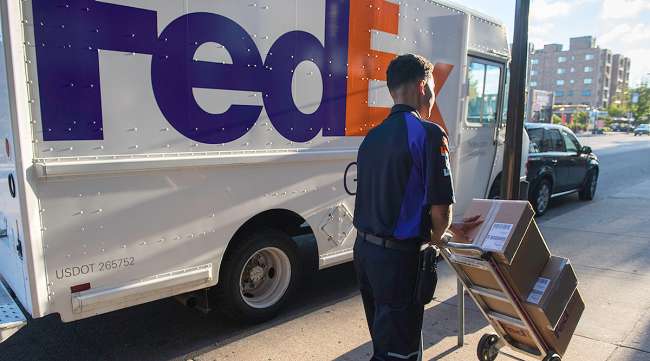Amazon-FedEx Split Sets Battle Lines in E-Commerce Delivery Feud

[Stay on top of transportation news: Get TTNews in your inbox.]
FedEx Corp.’s retreat from handling packages for Amazon.com Inc. signals that the lines are being drawn in the battle over surging e-commerce shipments.
The end of two delivery contracts with Amazon means FedEx will have to make up for the lost sales by extending a push to serve other customers such as Walmart Inc. Amazon will have to rely more on United Parcel Service Inc. and the U.S. Postal Service as it seeks to fulfill a pledge for next-day delivery to top customers — and build out its own shipping network.
The decision “represents the continued ‘drawing of a line’ in the sand between FedEx and arrangements/partnerships that do not fit its network,” Ben Hartford, an analyst with Robert W. Baird, said in a note to clients Wednesday. “FedEx will work to optimize and protect its network, while strengthening relationships with more strategically important customers.”
The common features for all involved: an ever-increasing flood of packages combined with greater pressure on profits. Online shopping accounts for only about 12% of retail sales, and shipments are expected to double in five years. But dropping off packages at homes tends to be less lucrative than at businesses, and Amazon is determined to drive the price lower while speeding delivery times.
Without details on how much Amazon is paying per package, it’s unclear who’s positioned for the biggest gains in the shakeup. If the price is low, UPS’ profit margins would be squeezed even as revenue rises. If the amount is in line with what other big customers pay, then FedEx walked away from profitable business that it will have to recoup elsewhere.
FedEx fell less than 1% to $160.66 at the close in New York. Amazon rose less than 1% to $1,793.40.
Amazon Risk
In a statement, Amazon said it was “constantly innovating to improve the carrier experience and sometimes that means reevaluating our carrier relationships.” It called FedEx “a great partner over the years.”
The loss of a major courier ahead of the peak holiday season increases the risk for Amazon as it promises quicker deliveries, said Marc Wulfraat, a logistics consultant and founder of MWPVL International.
Wulfraat estimates that Amazon will be able to handle about 45% of its own volume this year as it plows investment into sorting hubs, delivery stations and support for contract drivers. Amazon Air will have 70 dedicated aircraft in its network by 2021, the Seattle-based company said in June.
FedEx probably handled about 4% of Amazon’s volume, Wulfraat said, and the courier likely balked at the price the retailer wanted to pay for next-day deliveries. UPS delivers about 17% of Amazon packages while the post office accounts for a third, he said.
“I think Amazon played hardball and didn’t win,” Wulfraat said. “There’s kind of a lose-lose situation happening just in the short term.”
Wow. @FedEx is ending ground deliveries for @amazon. A recent analysis illustrates how the retailer is now a formidable competitor in logistics.https://t.co/kuS3mOU83z pic.twitter.com/u5UTaJoMQQ — Rakuten Intelligence (@Rakuten_Intel) August 7, 2019
UPS Volume
FedEx announced in June that it wouldn’t renew a U.S. air-shipping deal with Amazon, then said this week that a ground-delivery contract won’t be renewed when it expires at the end of this month. FedEx will still have a contract with Amazon for international deliveries, which in terms of size is “not worth mentioning,” said David Ross, an analyst at Stifel.
UPS — in the middle of a $20 billion, three-year investment spree to add capacity and boost efficiency — is poised to pick up the extra volume. The Atlanta-based company already scored a 30% spike in its next-day air business in the second quarter.
A spokesman for UPS declined to comment on specific customers.
UPS hasn’t said how much revenue it generates from Amazon, but if the total were more than 10%, the courier would be obligated to disclose the information in regulatory filings. UPS had revenue of $71.9 billion last year.
UPS ranks No. 1 on the Transport Topics list of the largest for-hire carriers in North America.
FedEx Moves
Amazon made up about 1.3% of FedEx’s sales last year. To scoop up more e-commerce business from other customers, FedEx announced in May that its ground unit would begin seven-day service in January, deliver more packages that had been handed off to the postal service and invest to handle oversized packages.
The Memphis, Tenn.-based company has also signed up more drop-off and pick-up points, including with Dollar General Corp. FedEx is even testing a ground-delivery robot.
Those moves “have us positioned extraordinarily well” to handle demand as it focuses “on the broader e-commerce market,” FedEx said.
The company will likely use the breakup as a selling point to Amazon competitors such as Walmart, Target Corp. and others. Goods sold through Amazon’s website are expected to account for almost 40% of e-commerce sales in the U.S. this year, according to EMarketer Inc.
FedEx will seek to “get Walmart to realize that they’re not working with Walmart’s biggest competitor and to have Walmart make FedEx their primary carrier,” Satish Jindel, founder of SJ Consulting Group, said on Bloomberg Radio.
FedEx ranks No. 2 on the Transport Topics list of the largest for-hire carriers in North America.
Spencer Soper and Matt Day contributed to this report.




